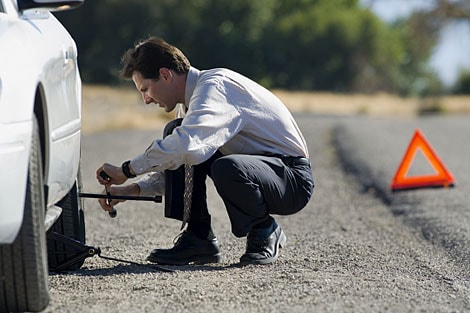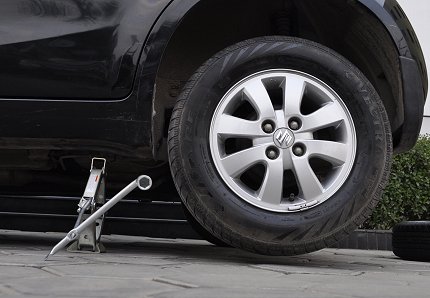How to Safely Change a Tire
Safety is Paramount

The first thing that you want to do when you get a flat is decide if it is safe to stop or not. You want to pull over in an area that is far from the flow of traffic, has a smooth and flat surface and allows you plenty of room to work. You also want to be in an area that is visible to others to reduce the risk of becoming a target for an opportunistic attacker or thief.
If you are pulling off to the side of the road, make sure that you turn your flashers on and set up warning devices or flares if you have them. You may also want to consider putting on a reflective vest, such as those that road workers use in order to increase your visibility to oncoming motorists. All of this can help to alert other motorists that you are up ahead and allow them to slow down, move out of the way or even stop and help. Many people are killed each year because an unsuspecting motorist crashes into vehicles that are pulled off to the side of the road.
Loosen Nuts First

It is important that you loosen all of the lug nuts on the wheel BEFORE you jack up the Vehicle. This will minimize the chances of knocking the vehicle off of the jack once it is raised. It will also prevent the wheel from spinning around as you try to loosen the nuts. Don’t remove the nuts completely. Just unscrew them enough so that they can be loosened easily with the lug wrench or by hand once the vehicle is raised off the ground.
Lifting the Vehicle

Every vehicle has spots along the chassis either in front or behind each wheel where the jack is to be placed. This will either be a pimple or a dimple or notch. Find this spot and insert the jack. Do not place the jack anywhere other than in one of these designated areas. Otherwise, you can damage the body, crack the frame or cause the vehicle to slip and fall after the tire is removed. You also run the risk of getting injured if your body is in the wrong place at the wrong time.
Consider using some wooden blocks as chocks to place behind other wheels if you are working on an uneven or rough surface to ensure that the vehicle won’t slip or move while you are changing the tire. You also want to make sure that the jack is firmly planted on the ground and not resting on debris or gravel. If the ground is not as stable as you would like, place a piece of plywood beneath the jack to provide some additional support.
Jack up the vehicle until the tire is completely raised above the ground. Make sure that you allow for some space to place the inflated spare onto the wheel as well. Chances are that the flat tire will be compressed and require less space than the spare that you will install.
Changing the Tire

Remove the lug nuts and place in the hub cap or somewhere else where they won’t roll away and get lost. Pull off the flat tire by wiggling it from side to side and up and down until it can be removed completely. Set aside. Place the spare against the wheel and align the holes in the rim to closely match the position of the bolts on the wheel. This will reduce the amount of adjustment that you need to make as you wrestle the new tire in place. Keep in mind that the tire will be heavy and bulky, so the less “fine-tuning” that you need to do will save you a lot of time and energy.
Lift the tire, slide the holes in the rim over the bolts and start to reattach the lug nuts.
Tightening the Nuts

It’s easiest to start with tightening the top lug nut before tightening one on the bottom. Then you can attach the sides and the other bottom one. This will vary from vehicle to vehicle, and most manuals in the glove box will show a diagram that indicates the preferred order of attachment. However, there are really no hard-and-fast rules as long as you get all of the nuts attached and secured. You may need to lean into the tire in order to press it against the wheel in order to get a snug fit. Tighten each screw by hand as much as possible before finishing it off with the lug wrench after you’ve lowered the vehicle and removed the jack. You may need to make a few passes in order to ensure that all of the nuts are secure.
Reattach the hub cap, remove the jack and place everything back in the trunk. If you are driving on a donut, make sure that you do not exceed the recommended speed limit that is stamped on the rim of the tire. You also want to be careful when driving over potholes, crossing train tracks or heading over uneven terrain. Keep your driving to a minimum until you can get a new tire in order to reduce wear and tear on the donut.
Always remember to replace the damaged tire as quickly as possible. You don’t want to be driving without a spare for too long, because you will be up the creek without a paddle if you happen to get another flat.
Finally, consider keeping an extra floor mat in the trunk, some work gloves or knee pads so that you will be more comfortable while changing a tire. These little things can make a huge difference in terms of reducing the need to plant your knees on rough or hot roadway surfaces.
Nobody likes changing a tire, but in reality, you can get the job done a lot faster than it would take for someone to come to your location and do it for you. Follow these guidelines and you will be able to save, time, energy and minimize the inconvenience as well as hazard of being disabled on the side of the road.

